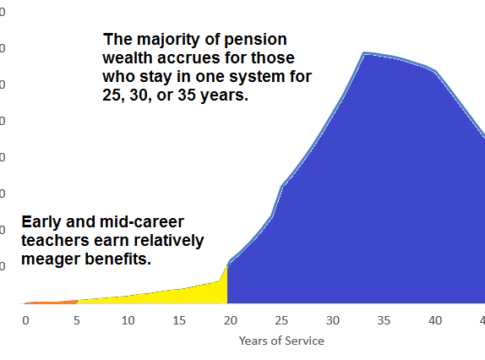Pension benefit increases were a painless way for politicians from both parties to provide something tangible to powerful interest groups without having to pay the costs immediately. A recent report provides empirical evidence to support this theory.
“The Politics of Pensions” by Sarah Anzia and Terry Moe compiles a unique data set looking at the politics surrounding pension legislation. By tracking pension legislation, partisanship, and media coverage from 1999 – 2011, the authors show that a dramatic shift in pension politics occurred before and after the recent recession.
Prior to the 2009 recession, states passed a number of laws enhancing pension benefits. Those laws expanded pension benefits, increased cost-of-living adjustments, lowered employee contributions, or made other changes to make retirement benefits more generous for public workers. Politicians could promise constituents pension increases, while pushing costs onto future generations and legislatures. From 1999 to 2008, states passed a total of 232 pension bills expanding pension benefits. After the economic recession, however, the political climate changed drastically. From 2010-11, 59 out of 63 pension bills issued some sort of reduction of pension benefits.
State Pension Legislation, 1999-2011

Pension legislation was primarily bipartisan up until the recent recession. Increasing benefits was a way for Democrats to respond to public sector constituents, and Republicans could support it as an issue that had little voter opposition. Before 2009, Republicans supported pension increases 92 percent of the time and Democrats supported benefit increases 97 percent of the time. After the recession, however, the politics on pensions changed sharply, and politicians increasingly voted along party lines. From 1999 to 2008, few pension bills were decided along party lines; of the bills passed in 2001, only 2 percent were decided along partisan lines by party unity votes. In 2011, party unity votes rose to 42 percent.
Partisanship on Public Pension Votes

Apart from pension beneficiaries, most voters weren’t aware of pension issues before the recession. The authors track the number of news clips related to state and local pensions using the New York Times as a proxy for media coverage. Before 2009, the media rarely covered pension issues. After 2009, however, the number of public pension news stories covered by the New York Times doubled. As seen in the graph below, the uptick in new stories happens at the same as the spike in partisanship in 2010.
Number of New York Times Storeis About State and Local Public Pensions

We traditionally see Democrats as supporters of public worker groups and Republicans as the antagonists striving to keep fiscal costs down. But before the recession, politicians on both sides of the aisle used pensions as an easy promise without consequences. Once states faced tough budget choices, then, the politics around pension legislation became increasingly partisan.
Figures Source: Sarah F. Anzia and Terry M. Moe, “The Politics of Pensions,” December 2013.
—Leslie Kan
Leslie Kan is a pensions analyst at Bellwether Education Partners.
This first appeared on teacherpensions.org




